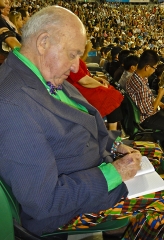
MELBOURNE — Call it Woeful Wednesday.
It was the day the Australian Open lost its leading man very unexpectedly – Rafa Nadal. And professional tennis lost one of its most appealing champions. For good, this time – Justine Henin.
Put them together and it was a huge, staggering hit for the game. There would be new champions. Roger Federer would fall to a confident Novak Djokovic (as he did in the U.S. Open semis), and the mysterious Serena didn’t make the starting line.
Women have walked out on me before, but this was the second desertion by the gifted Henin. I miss her already as I did in 2008 when she decided to quit the game and not shoot for a fifth French Open title. She was No. 1, a tiny shotmaking wizard of 5-foot-5 with the rifling one-handed backhand, the Paperweight Tiger competing brilliantly among the big babes, winning 43 championships, seven of them majors – four French, Two U.S, one Australian — and Olympic gold in 2004. Watching her was one of the treats of the game.
I, and innumerable others, were ecstatic when she decided to make a comeback at the end of 2009. She made it to the final here a year ago, losing to Serena, and her competitive and personal life looked good until she tumbled on her right elbow in a Wimbledon fourth rounder lost to Belgian rival Kim Clijsters. That kept her out, immersed in much rehab the rest of the year.

It didn’t help much. Seeded 11th she was beaten here in the third round by Svetlana Kuznetsova, and decided to call it a career.
“After consulting my doctors,” she said, “and considering their advice it is now clear and I accept that my career finally ends. I am sorry. I had hoped for a different return and dreamed of a different ending. My level on return did not reach expectations. Tests showed that the [elbow] joint was too fragile and hurt so that my passion and my profession at high level cannot continue to exist.”
“What a wonderful trip I have experienced over all these years,” said 28-year-old Justine, the only No. 1 in pro tennis to leave on top – her first desertion. A wonderful trip, too, for all of us who watched her. I hope she will keep in touch with the game. She has much to offer. She gained from the first retirement, a calmer mood, development of empathy and a desire to help others less fortunate.
What can I say? So you walked out on me again, Justine. I’m, glad for what you gave us.
Rafa, the defending champion a year ago, now has been knocked out of the Australian twice in a row by injury. Last time it was a knee. He had to surrender to Andy Murray. This time it was a pulled left hamstring that left him semi-immobilized from early in his 6-4, 6-2, 6-3 defeat by amigo David Ferrer.

Suffering from tendonitis in his knees, Nadal was unable in 2009 to defend his Wimbledon title. He snapped back to win the last three majors of 2010 (French, Wimbledon, U.S.) But a guy who hits and runs with such force, acting as if each point were the last of his life, may always have injury problems.
Nevertheless, in losing to Ferrer, a hopeless match that most players would have walked away from, defaulted, Rafa showed his strength of character. With his dream of holding four consecutive majors gone, tears in his eyes, he would not mention the injury, and gave his countryman, No. 7 Ferrer, full credit for the victory. He refused to shortchange Ferrer by exiting early – even though he risked hurting himself further by going all out as much as he could.
Now there’s a No, 1 hombre regardless of ranking.
Leave a Reply